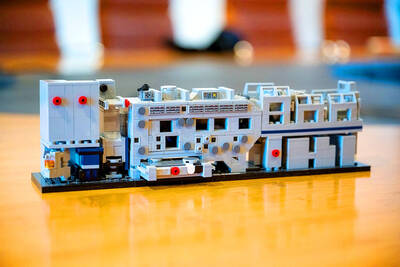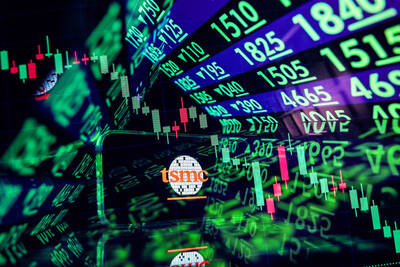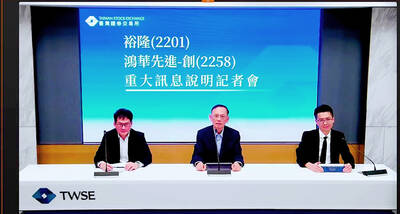From India to China to the US, automakers cannot make vehicles — not that no one wants any, but because a more than US$450 billion industry for semiconductors got blindsided. How did both sides end up here?
Over the past two weeks, automakers across the world have bemoaned the shortage of chips. Germany’s Audi, owned by Volkswagen AG, would delay making some of its high-end vehicles because of what chief executive officer Markus Duesmann called a “massive” shortfall in an interview with the Financial Times.
The firm has furloughed more than 10,000 workers and reined in production.

Photo: Reuters
That is a further blow to an industry reeling from COVID-19-induced shutdowns and a global market that had already been struggling under a growing regulatory push toward greener vehicles and the technology to keep up with the future of mobility.
Companies appear to have been off in their calculations that traditional auto production was all but coming to a halt, and that new-era vehicles were almost here.
In reality, talk of the death of the conventional auto industry has been premature. So were prospects around the technology upgrade that has been under way.
Yes, demand has been down and slowing, but we have been hovering around “peak auto” for a while, with global sales of 70 million to 80 million a year. They fell 15 percent to 66.8 million last year.
However, the expected onslaught of new-technology vehicles has not been as severe as the hype. Announcements of billions of dollars of investment covering electric to hydrogen and autonomous systems would have you believe that we have entered a new era of driving — or of being driven around. Yet electric and autonomous vehicles still account for only about 4 percent of all sales.
Misjudging expectations means that companies ended up effectively shelving too early their investment in the more mundane chips that help steer, brake and push up windows they actually need.
Meanwhile, chipmakers are not producing enough of them and have put money in higher-margin businesses. One result is that we are clearly at an imbalance of supply and demand.
Consider the number and types of semiconductor chips that go into a vehicle. Demand is not just about the number of automobiles, but how many chips each one needs. Electronic parts and components account for 40 percent of the cost of a new, internal-combustion engine vehicle, up from 18 percent in 2000.
That portion would continue to rise. It is becoming a problem across the board, and not just for higher-end models. India’s automakers’ association has complained of a shortage, and many vehicles there are relatively less sophisticated given pricing considerations.
So there was always going to be some sort of demand, whether you argued that more or fewer people would be driving.
Automotive electronics were expected to be the fastest-growing markets in the semiconductor industry, accounting for about 12 percent of sales revenue by next year, according to an April 2019 Deloitte report.
The 2022 model year is expected to be a key one. Credits that many automakers accumulated to meet greenhouse gas emission rules would expire at the end of the 2021 model year.
More compliant vehicles would be needed, and electrics and hybrids use twice the semiconductor content as traditional models, according to a PriceWaterhouseCoopers LLP report.
On the supply side, the concern was more around keeping up with technology. In October 2019, the likes of Samsung Electronics Co and SK Hynix Inc were contending with potential overproduction issues of certain types of chips. A year earlier, Taiwan Semiconductor Manufacturing Co (台積電), the world’s largest contract chipmaker, had sounded concerns about oversupply in 28-nanometer nodes — in demand for higher-end vehicle features at the time — as its other customers migrated to more advanced chipsets.
Part of the issue is that there is no fast substitute. Customers usually put orders in eight to 10 weeks ahead, but lead times have gotten much longer since the COVID-19 outbreak. Automakers in China, for instance, do not have more than a few weeks of supply on hand in keeping with lean, cost-friendly manufacturing operations.
There is also an equipment shortage, so foundries that make wafers typically suited for broad-based auto usage have limited capacity.
Chipmakers’ cycles — from development to certification — are long. Keeping track of and aligning with shifts in auto markets is difficult. The pandemic has not made that any easier. It seems that none of the players are quite in sync. The supply-demand balance is far too delicate. Even if consumer electronics are sucking up the chip supply, with everyone suddenly playing a lot more video games or increasing use of personal computers, manufacturers should not be disabled from making vehicles.
Everyone’s math ought to add up better than this.
Anjani Trivedi is a Bloomberg Opinion columnist covering industrial companies in Asia. She previously worked for the Wall Street Journal.
This column does not necessarily reflect the opinion of the editorial board or Bloomberg LP and its owners.

In a high-security Shenzhen laboratory, Chinese scientists have built what Washington has spent years trying to prevent: a prototype of a machine capable of producing the cutting-edge semiconductor chips that power artificial intelligence (AI), smartphones and weapons central to Western military dominance, Reuters has learned. Completed early this year and undergoing testing, the prototype fills nearly an entire factory floor. It was built by a team of former engineers from Dutch semiconductor giant ASML who reverse-engineered the company’s extreme ultraviolet lithography (EUV) machines, according to two people with knowledge of the project. EUV machines sit at the heart of a technological Cold

Taiwan’s long-term economic competitiveness will hinge not only on national champions like Taiwan Semiconductor Manufacturing Co. (TSMC, 台積電) but also on the widespread adoption of artificial intelligence (AI) and other emerging technologies, a US-based scholar has said. At a lecture in Taipei on Tuesday, Jeffrey Ding, assistant professor of political science at the George Washington University and author of "Technology and the Rise of Great Powers," argued that historical experience shows that general-purpose technologies (GPTs) — such as electricity, computers and now AI — shape long-term economic advantages through their diffusion across the broader economy. "What really matters is not who pioneers

Taiwan Semiconductor Manufacturing Co (TSMC, 台積電) last week recorded an increase in the number of shareholders to the highest in almost eight months, despite its share price falling 3.38 percent from the previous week, Taiwan Stock Exchange data released on Saturday showed. As of Friday, TSMC had 1.88 million shareholders, the most since the week of April 25 and an increase of 31,870 from the previous week, the data showed. The number of shareholders jumped despite a drop of NT$50 (US$1.59), or 3.38 percent, in TSMC’s share price from a week earlier to NT$1,430, as investors took profits from their earlier gains

TAIWAN VALUE CHAIN: Foxtron is to fully own Luxgen following the transaction and it plans to launch a new electric model, the Foxtron Bria, in Taiwan next year Yulon Motor Co (裕隆汽車) yesterday said that its board of directors approved the disposal of its electric vehicle (EV) unit, Luxgen Motor Co (納智捷汽車), to Foxtron Vehicle Technologies Co (鴻華先進) for NT$787.6 million (US$24.98 million). Foxtron, a half-half joint venture between Yulon affiliate Hua-Chuang Automobile Information Technical Center Co (華創車電) and Hon Hai Precision Industry Co (鴻海精密), expects to wrap up the deal in the first quarter of next year. Foxtron would fully own Luxgen following the transaction, including five car distributing companies, outlets and all employees. The deal is subject to the approval of the Fair Trade Commission, Foxtron said. “Foxtron will be